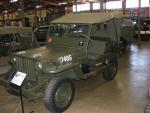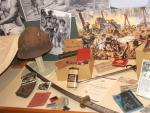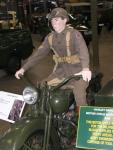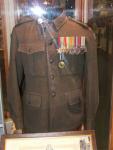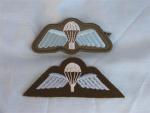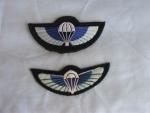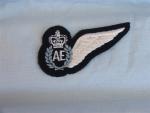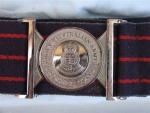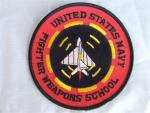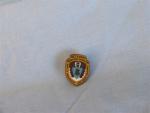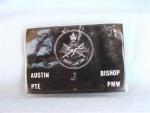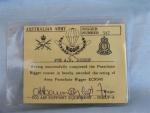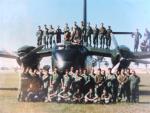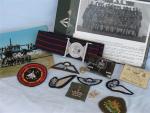-
Posts
1,782 -
Joined
-
Last visited
Content Type
Profiles
Forums
Blogs
Gallery
Events
Store
Everything posted by Bob Lyons
-
Hi all, I hope this is the right place to give these photos a home, I travel up to see my eldest son who is currently serving in New South Wales, and on the way, there is a great little museum at the Army centre just outside of Wodonga, at Bandiana, which is just inside the Victorian border with New South Wales, they have a great display of Aussie uniforms and equipment going back to the Boer War, and right through to todays peacekeepers, will start my tour with a display from the 1st World War, horses and mess wagon.
-
Didn't come out as I had planned, but it gives the picture I think. My wife just came back from visiting our son, who is instructing at 1st Recruit Training Battalion at Kapooka, New South Wales, and whilst she was there, she dropped in at a garage sale, and picked this lot up for the princely sum of three bucks... Bob
-
<H4 align=center>Current Australian Army Rising Sun Badge</H4> Proudly worn by soldiers of the 1st and 2nd Australian Imperial Forces in both World Wars, the 'Rising Sun' badge has become an integral part of Digger tradition. The distinctive shape, worn on the upturned brim of a slouch hat, is readily identified with the spirit of ANZAC. Yet despite the badge's historic significance, well researched theories as to its origin are more numerous than its seven points. In 1902 a badge was urgently sought for the Australian contingents raised after Federation for service in South Africa during the Boer War. Probably the most widely-accepted version of the origin of this badge is that which attributes the selection of its design to a British officer, Major General Sir Edward Hutton, KCB, KCMG, the newly appointed Commander-in-chief of the Australian Forces. He had earlier received as a gift from Brigadier General Joseph Gordon, a military acquaintance of long standing, a "Trophy of Arms" comprising mounted cut and thrust swords and triangular Martini Henri bayonets arranged in a semicircle around a brass crown. To Major General Hutton the shield was symbolic of the co-ordination of the Naval and Military Forces of the Commonwealth. A refurbished replica of the shield is on display in the main foyer of Army Office in Canberra. The original design, created and produced in haste for issue to the contingent departing to South Africa, was modified in 1902 and 1904. The 1904 badge, in pressed copper was worn by the AIF through both World Wars. Since its inception the basic form of the 1904 version has remained unchanged although modifications have been made to the wording on the scroll and to the style of crown. In 1949, when Corps and Regimental Badges were reintroduced into service, the wording on the scroll of the "Rising Sun" Badge was changed to read "Australian Military Forces". HM Queen Elizabeth ascended to the throne on the death of King George V1 and the Crown on the badge was subsequently changed from a Kings Crown to a Queen's Crown on the 1956 version. Twenty years later, the badge was again modified to incorporate the Federation Star and Torse Wreath from the original 1902 version of the badge and the scroll wording changed to "Australia" In the 75th anniversary year of the ANZAC landings at Gallipoli there arose a desire to return to the traditional accoutrements worn by Australian soldiers during the World Wars and which clearly identify the Australian Army. The recent change coincides with the 90th anniversary of the Army which was commemorated on 1st March 1991.
-
Unofficial Rising Suns <<< Another unofficial RSB from WW1. The motto reads "Australia for the Empire and our Allies" Unofficial, rough cast Rising Sun badge with three pin fastenings soldered to the reverse, featuring an image of Australia under two crossed rifles, bordered above by a Rising Sun. In the centre of the base of the badge, between the rifles, is the text 'AUSTRALIA' and slightly above the text, on either side, is a border of wattle. <FONT size=2>The badge appears to be an example of trench art.<SPAN style="COLOR: black; FONT-FAMILY: Arial">
-
Cadet Corps Rising Suns In pre WW1 Australia all eligible males were required to do some sort of military training. It started at age 12 with Junior Cadets and progressed through all of your life in one form or another until age 45. note that early Cadet Corps Unit badges only had 7 points, not 13 The badge, above left, is the one worn by junior Cadet Corps units. Badge of the NSW Senior Cadet Corps formed in 1907. This was based on the 2nd pattern of RSB not the more recent 1904 version This badge is featured in Cossum's The Rising Sun Badge book (pg 15 RS52). The badge is possibly a school cadet cap or collar (in the absence of any unit name or number it is probably a collar badge).Nice enamel and gilt badge with flat lugs on the reverse. Scotch College Cadet Corps Murray High School Cadet Unit Tasmania
-
Goldfields Infantry Regiment 1903/12WW2 variation of unknown origin46 Battalion The Brighton RiflesBritish Red Cross (Australian Div) circa 1916 The 27th was a South Australian Militia regiment, and in the period of 1930 to 1942, it had a Scottish nature. After WW2 the 27th Scottish South Australian continued.The ties to the Seaforth Highland Regiments were strong and the kilts worn were the same. The hat badge is based on the Australian Rising Sun badge, with the stag's head of the Seaforths in the centre, and 27 between the antlers on the sun. The scroll reads, South Australian Scottish Regiment, and with the Latin phrase, Primus Inter Pares, meaning First Among Equals.This badge was designed to be worn as a Sporran and Bonnet Badge. Captain John Francis PLACE designed this badge and the collar badges of the 27th Battalion and submitted the designs on the 22nd of January, 1938. The badges were then manufactured by G A Miller & Sons Ltd. of Sydney, New South Wales This AUST'N MILITARY FORCES badge was woven on khaki. The sunburst was blue and the crown was red. It was issued to AIF volunteers in training when the Armistice was declared in 1918.Because of the huge appeal of the Rising Sun badge many units and some Corps tried to work it into their badge designs. This is an early version of a collar badge for an Australian armoured unit.
-
more... Some units incorporated the Rising Sun into their badge, as did 32nd Bn AMF. 5th Australian Infantry Regiment (5AIR) also managed to use the Rising Sun Australian Instructional Corps This unit originally started with a standard pattern General Service (Rising Sun) badge embellished with the addition of enamel. Later (circa 1930/39) they got their own badge (note the changes to wording on the scroll). WWI 1st Remount Unit Australian Light Horse - Rising Sun, unofficialAs listed in "Australian Army Badges, The Rising Sun Badge" page 13 ref.# RS42. J K Cossum This version of the ACMF RSB is quite different from the normal. At this stage it remains unidentified as to manufacturer, era or distribution
-
re the first post (rising sun) will see if I can post this: - More details on Australia's most famous badge General Service badges for the AIF were manufactured by several firms. Although the standard always reached the Government regulated minimum standard some were better than the minimum standard. This is an example of one of the better quality ones. It was manufactured in Birmingham, England. This is another version from the same era. Note the lack of detail and the variations in the crowns. Chromium plated as worn by RAAC post 1945 EnameledCommonwealth HQ Staff 1904Australian Instructional Corps c.1930
-

Luftwaffe Juncker LW Para
Bob Lyons replied to Jan Arne S's topic in Germany: Third Reich: Wehrmacht Medals, Decorations & Awards
and I second Eric's comments! Bob -

Luftwaffe Hi Ho 'Silver'!
Bob Lyons replied to ERIC's topic in Germany: Third Reich: Wehrmacht Medals, Decorations & Awards
beyooootiful Bob



